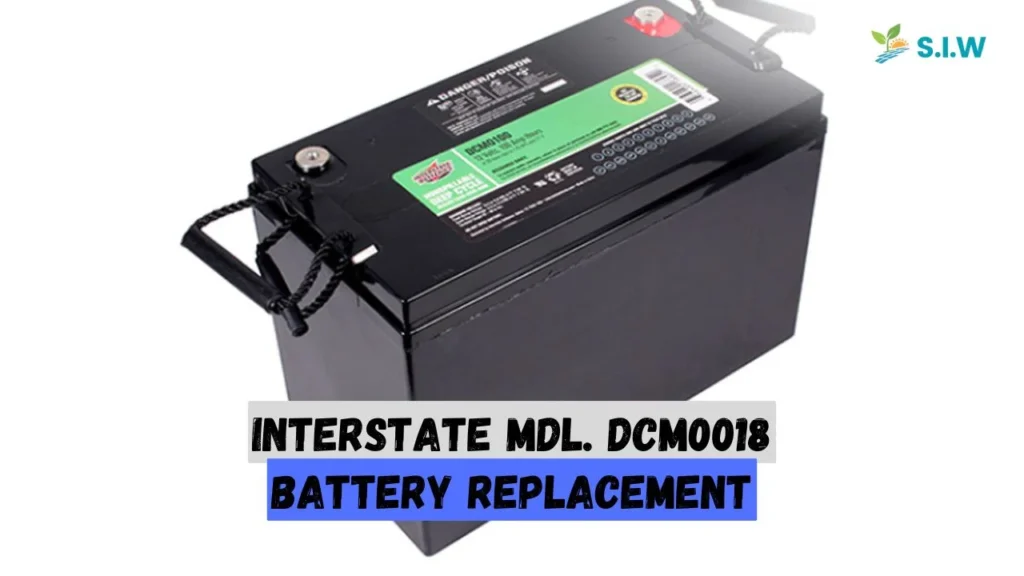When it comes to reliable power solutions, the Interstate MDL. DCM0018 battery stands out as a widely used option in both automotive and solar applications. Over time, even the best batteries wear out and require replacement, and a well-timed change can significantly enhance performance. This comprehensive guide will help you navigate the process of replacing your MDL. DCM0018 battery, discussing crucial specifications, handling tips, and best practices to ensure optimal functionality.
Understanding the Interstate MDL. DCM0018 Battery
The Interstate MDL. DCM0018 is a deep-cycle battery designed for long-lasting performance. This model is frequently used in a variety of applications due to its durability, low maintenance, and power reliability. It’s especially popular among solar energy enthusiasts who rely on consistent energy storage for renewable power systems.
Key Specifications of the Interstate MDL. DCM0018 Battery
The MDL. DCM0018 has impressive specifications that make it ideal for both automotive and solar energy applications:
- Voltage: 12V
- Capacity: 18Ah
- Battery Type: Deep Cycle AGM (Absorbed Glass Mat) – Maintenance-free
- Weight: Approximately 12 pounds
- Dimensions: 7.13 x 3.01 x 6.57 inches
This battery’s sealed AGM technology prevents leaks and ensures a longer lifespan, making it a perfect choice for uninterrupted power supplies (UPS), medical equipment, and, notably, solar energy systems where longevity and reliability are crucial.
When to Replace Your Interstate MDL. DCM0018 Battery
Identifying the right time for a replacement ensures the seamless performance of your equipment. Here are some signs indicating that your MDL. DCM0018 battery needs replacing:
- Decreased Capacity: If the battery isn’t holding a charge as well as it used to, it may be time for a replacement.
- Increased Charge Time: A battery that takes unusually long to charge could be nearing the end of its lifespan.
- Visible Damage: Bulging, cracks, or leaks indicate serious wear and tear that warrants immediate replacement.
- Frequent Shutdowns: When your system frequently loses power, it’s likely a result of battery wear.
Regular checks can help you identify these issues early, preventing system malfunctions and ensuring optimal functionality.
Step-by-Step Guide to Interstate MDL. DCM0018 Battery Replacement
Here’s a detailed process for replacing your Interstate MDL. DCM0018 battery safely and efficiently:
1. Gather Necessary Tools and Equipment
Before beginning, gather the necessary items:
- Replacement MDL. DCM0018 battery
- Wrench or screwdriver
- Insulated gloves for safe handling
- Protective eyewear
2. Turn Off and Disconnect the Device
Ensure all power is off before removing the old battery to avoid electrical shocks. Disconnect any connected cables and remove the battery from its compartment.
3. Remove the Old Battery
Carefully detach the old battery by unscrewing or unclamping it from its position. Be cautious of any acid leaks or corrosion, as these can cause burns and other damage. Always handle the battery with care to prevent accidental spills.
4. Insert the New MDL. DCM0018 Battery
Place the new battery in the same orientation as the old one. Tighten any clamps or screws to secure it in place, ensuring a snug fit to prevent movement.
5. Reconnect the Device
Reconnect the power cables, ensuring the terminals are clean and firmly attached. Turn on the device to check that the battery functions properly.
6. Test the Battery
Perform a quick test to ensure everything is working as expected. For automotive applications, start the engine and monitor the power levels. In solar or UPS setups, monitor the battery’s charge and discharge cycles over a few hours.
Battery Maintenance Tips for Prolonged Life
A few simple maintenance steps can extend the life of your MDL. DCM0018 battery and enhance its performance:
- Keep Terminals Clean: Corrosion can reduce battery efficiency; regularly clean terminals with a soft brush and baking soda solution.
- Charge Correctly: Avoid overcharging, as this can damage the battery. Use a smart charger designed for AGM batteries to prevent overcharging.
- Store in Cool, Dry Places: Excessive heat can degrade battery performance, so keep it in a moderate environment whenever possible.
- Perform Regular Checks: Monitor the battery’s voltage and charge cycle regularly to spot any performance drops early.
Interstate MDL. DCM0018 Battery and Solar Applications
The MDL. DCM0018 is a popular choice in solar energy systems due to its deep-cycle design and ability to store significant energy for later use. In solar setups, this battery acts as a backup power source, storing surplus energy generated during the day for use during nighttime or cloudy periods. The DCM0018’s low maintenance and high reliability make it ideal for off-grid solar installations where consistent power storage is essential.
Frequently Asked Questions (FAQs)
Q1: How long does the Interstate MDL. DCM0018 battery last?
The lifespan depends on usage and maintenance but typically ranges from 3 to 5 years with regular upkeep.
Q2: Is the MDL. DCM0018 battery suitable for solar power?
Yes, the MDL. DCM0018 is highly suitable for solar power due to its deep-cycle design and reliable power storage capabilities.
Q3: Can I replace the MDL. DCM0018 battery myself?
Yes, with proper precautions, you can replace it yourself. Ensure you follow safety guidelines, such as disconnecting power and wearing protective gear.
Q4: How do I dispose of an old MDL. DCM0018 battery?
It’s best to recycle old batteries at certified recycling centers to minimize environmental impact. Many retailers offer battery recycling services.
Q5: What maintenance does the MDL. DCM0018 require?
Routine terminal cleaning and avoiding overcharging are the primary maintenance requirements for this battery.
For those relying on their MDL. DCM0018 battery in critical setups, keeping it in optimal condition is vital for uninterrupted power.








